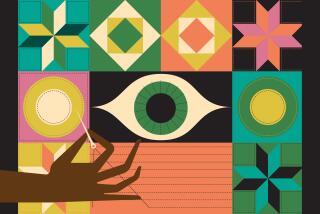Thee Best Have Money and Patience if Thee Want a Quilt
- Share via
If you crave an Amish quilt, “don’t expect to go knocking on the doors of farmhouses,” warns Elizabeth V. Warren, curator of the Museum of American Folk Art in New York City. “Any that are left are saved by families for special occasions.
“Amish quilts are hot, put it that way. They’re very scarce today. A good wool quilt from Lancaster County, Pa., is a very, very rare item. When you do find one in good condition it may cost you many thousands--$5,000 to $10,000 and up. Midwestern Amish quilts are cotton and less expensive but still (cost) in the thousands.”
“Don’t buy what you don’t love just because it’s an Amish quilt,” Warren advises. “Buy the best you can afford--don’t look for a bargain. Don’t settle for a quilt in bad condition. . . . Don’t buy one that’s falling apart and say, ‘I’ll get it repaired.’
“There are reasons why certain quilts cost less. If you go to a dealer, and they have a whole range, ask why some are less than others. A more interesting pattern, better colors are going to make a quilt more expensive than a common pattern in dull colors.
“Also, be careful: You’ll see a “Diamond in the Square” or “Sunshine in Shadow” (two old quilt patterns) for $2,000, and you’ll think, ‘My God, that’s a bargain,’ but a lot of quilts that are still being made and have been made in the last 20 years are made with synthetic fabric (in harsh colors), and the quilting won’t be as good.”
Most of the best quilts were made before the early 1940s, Warren says, when exquisite stitching was still the rule. With the advent of a collectors’ market, some Amish began turning out made-to-order quilts in traditional patterns rather than relying on home-grown inspiration.
Warren suggests that quilt fanciers may want to visit the Esprit Corp.’s San Francisco corporate office at 900 Minnesota St., which houses “the best collection of Amish quilts I have ever seen.”
The 248 quilts, made between 1870 and 1950 (a third of which are on display throughout the building at any given time) may be viewed Monday through Friday, from 9 a.m. to 4:30 p.m. A self-guided tour, including an illustrated catalogue, costs $3.73 including tax. Groups of six or more must take turns so as not to disturb office workers. Call (415) 648-6900 for more information.
In Los Angeles, the American Quilt Research Center at the Los Angeles County Museum of Art won’t open to the public until December, 1988. In the meantime, though, anyone with a special area of interest may make an appointment to use the library or see quilts in the collection (which spans all periods and includes only five Amish quilts) by calling Sandi Fox, senior research associate, at (213) 857-6083.
Although Warren says the definitive book on Amish quilts remains to be written, she recommends Robert Bishop’s and Elisabeth Safanda’s “A Gallery of Amish Quilts” (E.P. Dutton). Picture books on the subject include “Quilts of the Indiana Amish” by David Pottinger (Dutton) and Rachel and Kenneth Pellman’s “The World of Amish Quilts” (Good Books, Intercourse, Pa.), which deals with contemporary quilt making.
At the Bowers Museum in Santa Ana, the bookstore has acquired a stock of Amish-related items, and a number of quilt activities are on tap.
On Feb. 21, from 2 to 4 p.m., antique quilt authority Sabra Petersmannc will help date old quilts (bring two or three of yours) and give collecting and care information.
Quilting demonstrations by various Southern California quilting guilds will be offered on most Sundays throughout the run of the exhibit.
Quilting workshops will be held each Thursday and Saturday in February in the Large Conference Room of the Bowers Museum Education Center. Information: (714) 972-1900
More to Read
Sign up for The Wild
We’ll help you find the best places to hike, bike and run, as well as the perfect silent spots for meditation and yoga.
You may occasionally receive promotional content from the Los Angeles Times.






